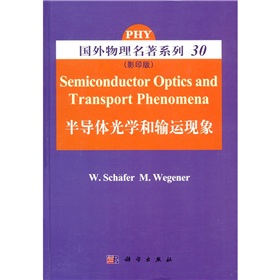半导体光学和输运现象 电子书下载 PDF下载

内容简介
Well-balanced and up-to-date introduction to the field of semiconductor optics, including transport phenomena in semiconductors. Starting with the theoretical fundamentals of this field the book develops, assuming a basic knowledge of solid-state physics. The application areas of the theory covered include semiconductor lasers, detectors, electro-optic modulators, single-electron transistors, microcavities and double-barrier resonant tunneling diodes. One hundred problems with hints for solution help the readers to deepen their knowledge.
·查看全部>>
目录
1.Some Basic Facts on Semiconductors
1.1 Semiconductor Heterostructures
1.2 Doped and Modulation-Doped Semiconductors
2.Interaction of Matter and Electromagnetic Fields
2.1 Microscopic Maxwell Equations
2.2 The Many-Particle Hamiltonian
2.3 Second Quantization for Particles
2.4 Quantization of Electromagnetic Fields
2.4.1 Coherent States
2.5 The Interaction Hamiltonian of Fields and Particles
2.6 Macroscopic Maxwell Equations and Response Functions
2.6.1 Direct Calculation of Induced Charges and Currents
2.6.2 Phenomenological Theory of Linear Response
2.6.3 Time-Dependent Perturbation Theory
2.6.4 Longitudinal Response Functions
2.6.5 Transverse Response Functions
2.7 Measurable Quantities in Optics
2.7.1 Linear Optical Susceptibility and Macroscopic Polarization
2.7.2 Absorption Coefficient
2.8 Problems
3.One-Particle Properties
3.1 Hartree-Fock Theory for Zero Temperature
3.2 Hartree-Fock Theory for Finite Temperature
3.3 Band Structure and Ground-State Properties
3.3.1 The Local-Density Approximation
3.3.2 Lattice Periodicity
3.4 The Effective-Mass Approximation
3.5 kp Perturbation Theory for Degenerate Bands
3.6 Transition Matrix Elements
3.7 Density of States
3.8 Position of the Chemical Potential
3.9 Problems
4.Uncorrelated Optical Transitions
4.1 The Optical Bloch Equations
4.2 Linear Optical Properties
4.3 Nonlinear Optical Properties
4.3.1 Perturbation Analysis in the Frequency Domain
4.3.2 Introducing the Bloch Vector
4.3.3 Perturbation Analysis in the Time Domain
4.3.4 Alternative Approaches
4.4 Semiconductor Photodetectors
4.4.1 The Field-Field Correlation Function and its Relation to Coherence
4.5 Problems
5.Correlated Transitions of Bloch Electrons
5.1 Equations of Motion in the Hartree-Fock Approximation
5.2 Linear Optical Properties:The Continuum of Interband Transitions
5.2.1 The Bethe-Salpeter Equation
5.2.2 The Dielectric Function
5.3 Solution by Continued Fractions
5.4 Problems
6.Correlated Transitions near the Band Edge
6.1 The Semiconductor Bloch Equations
6.2 Linear Optical Properties: Bound Electron-Hole Pairs
6.2.1 The Coulomb Green's Function
6.2.2 Optical Properties due to Bound Electron-Hole Pairs .
6.2.3 Numerical Methods
6.2.4 Excitons in Quantum Wells
6.2.5 Propagation of Light: Polaritons and Cavity Polaritons
6.3 Nonlinear Optical Properties
6.3.1 The Local-Field Approximation
6.3.2 Numerical Solutions
6.4 Problems
7.Influence of Static Magnetic Fields
7.1 One-Particle Properties
7.1.1 Effective Mass Theory for Isolated Bands
7.1.2 Degenerate Bloch Electrons in a Magnetic Field
7.1.3 One-Particle States in Quantum Wells
7.2 Optical Properties of Magneto-Excitons
7.2.1 Evaluation of the Coulomb Matrix Element
7.2.2 Linear Optical Properties
……
8.Influence of Static Electric Fields
9.Biexcitons
10.Nonequilibrium Green's Functions
11.The Electron-Phonon Interaction
12.Scattering and Screening Processes
13.The Semiconductor Laser.
14.Classical Transport
15.Electric Fields in Mesoscopic Systems
16.Electric and Magnetic Fields in Mesoscopic Systems.
References
Index
1.1 Semiconductor Heterostructures
1.2 Doped and Modulation-Doped Semiconductors
2.Interaction of Matter and Electromagnetic Fields
2.1 Microscopic Maxwell Equations
2.2 The Many-Particle Hamiltonian
2.3 Second Quantization for Particles
2.4 Quantization of Electromagnetic Fields
2.4.1 Coherent States
2.5 The Interaction Hamiltonian of Fields and Particles
2.6 Macroscopic Maxwell Equations and Response Functions
2.6.1 Direct Calculation of Induced Charges and Currents
2.6.2 Phenomenological Theory of Linear Response
2.6.3 Time-Dependent Perturbation Theory
2.6.4 Longitudinal Response Functions
2.6.5 Transverse Response Functions
2.7 Measurable Quantities in Optics
2.7.1 Linear Optical Susceptibility and Macroscopic Polarization
2.7.2 Absorption Coefficient
2.8 Problems
3.One-Particle Properties
3.1 Hartree-Fock Theory for Zero Temperature
3.2 Hartree-Fock Theory for Finite Temperature
3.3 Band Structure and Ground-State Properties
3.3.1 The Local-Density Approximation
3.3.2 Lattice Periodicity
3.4 The Effective-Mass Approximation
3.5 kp Perturbation Theory for Degenerate Bands
3.6 Transition Matrix Elements
3.7 Density of States
3.8 Position of the Chemical Potential
3.9 Problems
4.Uncorrelated Optical Transitions
4.1 The Optical Bloch Equations
4.2 Linear Optical Properties
4.3 Nonlinear Optical Properties
4.3.1 Perturbation Analysis in the Frequency Domain
4.3.2 Introducing the Bloch Vector
4.3.3 Perturbation Analysis in the Time Domain
4.3.4 Alternative Approaches
4.4 Semiconductor Photodetectors
4.4.1 The Field-Field Correlation Function and its Relation to Coherence
4.5 Problems
5.Correlated Transitions of Bloch Electrons
5.1 Equations of Motion in the Hartree-Fock Approximation
5.2 Linear Optical Properties:The Continuum of Interband Transitions
5.2.1 The Bethe-Salpeter Equation
5.2.2 The Dielectric Function
5.3 Solution by Continued Fractions
5.4 Problems
6.Correlated Transitions near the Band Edge
6.1 The Semiconductor Bloch Equations
6.2 Linear Optical Properties: Bound Electron-Hole Pairs
6.2.1 The Coulomb Green's Function
6.2.2 Optical Properties due to Bound Electron-Hole Pairs .
6.2.3 Numerical Methods
6.2.4 Excitons in Quantum Wells
6.2.5 Propagation of Light: Polaritons and Cavity Polaritons
6.3 Nonlinear Optical Properties
6.3.1 The Local-Field Approximation
6.3.2 Numerical Solutions
6.4 Problems
7.Influence of Static Magnetic Fields
7.1 One-Particle Properties
7.1.1 Effective Mass Theory for Isolated Bands
7.1.2 Degenerate Bloch Electrons in a Magnetic Field
7.1.3 One-Particle States in Quantum Wells
7.2 Optical Properties of Magneto-Excitons
7.2.1 Evaluation of the Coulomb Matrix Element
7.2.2 Linear Optical Properties
……
8.Influence of Static Electric Fields
9.Biexcitons
10.Nonequilibrium Green's Functions
11.The Electron-Phonon Interaction
12.Scattering and Screening Processes
13.The Semiconductor Laser.
14.Classical Transport
15.Electric Fields in Mesoscopic Systems
16.Electric and Magnetic Fields in Mesoscopic Systems.
References
Index
同类热门电子书下载更多
Copyright © 2025 by topbester.com.
All Rights Reserved.
沪ICP备14027842号-1
All Rights Reserved.
沪ICP备14027842号-1